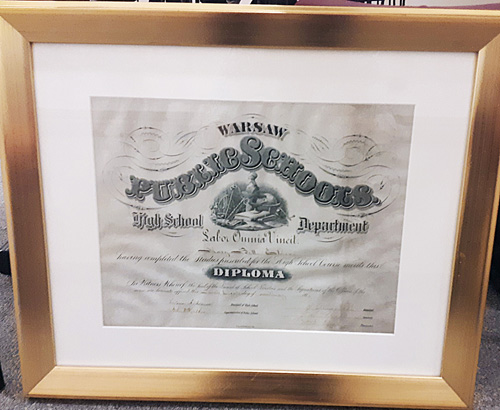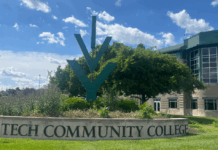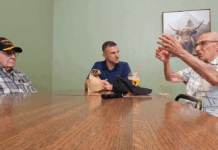
Warsaw Community Schools is celebrating 175 years of public education in Warsaw.
While there are no celebration plans set in stone yet, Superintendent Dr. David Hoffert said the district will look to plan celebratory events in the spring.
The grand opening of the Student Activity Center on Oct. 9, however, while it is a celebratory event, is not focused on the 175 years of education in the area.
Warsaw became a town in March 1854.
Dedicated To Education
According to the book “Schools of Kosciusko County 1835-1975” by Kosciusko County Historical County Genealogy Library, the first school in Warsaw was an 18-foot-by-28-foot structure on Fort Wayne Street in 1844, taught by Joseph A. Funk. Funk had a salary of $17 a month.
1844 was before the Civil War and President Abraham Lincoln.
“Indiana has a very interesting history when it comes to education. It used to be 1 out of every 16 parcels of land went to fund or create a school in Indiana,” Hoffert said.
“The reason why I think our schools have been so successful and why our community has been so successful is because of the strong partnerships that they have,” Hoffert said. “It shows public education has always been a priority here in the community since the beginning and founding of its days.
Hoffert, being a fourth-generation Warsaw resident, stated he has seen changes in the school district as his great-grandfather came to Warsaw after the Spanish-American War. Hoffert’s grandfather was a Warsaw graduate and Hoffert got to hear all of his grandfather’s stories and see where the old high school was.
Center Ward School was the first high school in Warsaw. It was built on the site of the Old Union School at Market and Detroit streets, according to “Schools of Kosciusko County 1835-1975.”
When the population grew, the high school reached capacity and a new high school was built on Main Street between Washington and Columbia streets. The new high school served students in ninth through 12th grade until 1936, when an addition was added and so was the freshman class.
A Community’s Heart
However, the high school is not the only school in the district with a history.
The high school on Main and Washington continued until 1962 when a new school was built on Smith Street. The Main and Washington school became the freshman high school, housing only freshman, according to the Historical Society book. An addition to the high school on Smith Street, at a cost of $338,000, was constructed in 1965.
According to the book, West Ward School was built in 1872 and renamed to Madison in 1960.
According to another book, “A History of the City of Warsaw, Indiana” by Michelle J. Bormet, groundbreaking for a new school was in 1953 and the first classes started there the following year. Washington was originally named West Wayne School, located on South Union Street, and cost $30,000 to build. It was attended by students from the western part of Wayne Township.
According to the Historical Society book, all elementary schools were renamed in 1960 after U.S. presidents. West Wayne became Washington and East Wayne became Jefferson.
Lincoln was bult in 1959 at the intersection of Lincoln and Main streets. Edgewood Middle School was built at 900 S. Union St. in 1975. Harrison, 1300 Husky Trail, and Eisenhower Elementary, 1900 S. Country Farm Road, were built in 1991.
“You realize how fast time goes,” Hoffert said. “I remember when the high school opened up for the first class.”
The current Warsaw Community High School was built in 1990.
Warsaw is based around education, Hoffert said. “This is a community that believes that is important,” he said.
There is one thing that Hoffert said hasn’t changed about Warsaw schools.
“I think Warsaw will always have the same heart it always did,” Hoffert said. “Warsaw is a special place. When we talk about the missions statement, the last part of it is about enriching lives and enriching lives of others.”
Preparing For The Future
There are some things the school district is implementing to help the school district improve on what it has. The first is more STEM education.
The school board approved $8 million in general obligation funds last month, and one of the things planned with the bond money is to update the STEM labs in the high school.
Another thing is dual-language immersion, Hoffert said.
The school district is also offering a variety of classes, such as high-level math classes, orchestra, Junior ROTC and more. Languages offered include Spanish, Mandarin Chinese, French and German.
From the onset, Warsaw Schools is trying to get students thinking about their career path.
When he was a student at Warsaw, Hoffert said the schools weren’t so much pathway based.
“Now we’re trying to develop students’ dreams early,” he said. The district is also preparing students to develop their dreams with a greater purpose.
In kindergarten, teachers are starting to ask students what their dreams are. Hoffert said those could very well change several times throughout the student’s tenure in the school system.
The high school also works with students and parents on their four-year plan.
Warsaw Schools isn’t just focusing on getting students to a university. Trade schools are an option.
Hoffert said universities aren’t for everyone and there are certain jobs that have shortages, so students are able to work toward a work ethics certificate while at Warsaw. Currently, 150 students are part of the program. There are a number of metrics students have to meet to get the certificate, such as maintain a certain GPA. Completing the work ethics certificate allows students to get things like get preferential interviews for jobs.
“It’s more based on what the students are doing here,” Hoffert said.
In a supply-and-demand world, Hoffert said he wants to make sure WCS’s education is demanded.
When looking to the future, Hoffert seemed to have hope.
“I really think (the school district) will be thriving,” he said, also stating that there will be things that will be going on in another 175 years that people today can’t wrap their minds around. When schools started in Indiana, the founding members couldn’t imagine the technology that exists today.




